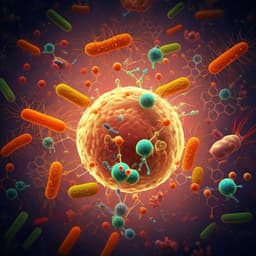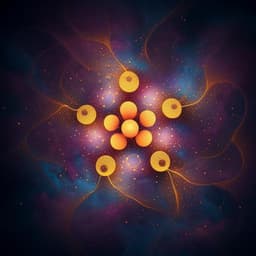
Medicine and Health
Me, myself, bye: regional alterations in glutamate and the experience of ego dissolution with psilocybin
N. L. Mason, K. P. C. Kuypers, et al.
Discover groundbreaking research by N. L. Mason and colleagues exploring how psilocybin affects glutamate levels in the brain and its fascinating ties to ego dissolution. This study reveals intriguing region-dependent changes in glutamate that may illuminate psilocybin's therapeutic potential.
~3 min • Beginner • English
Introduction
Psychedelics induce altered states of consciousness, including ego dissolution, and are being reconsidered for treating psychiatric conditions marked by distortions of self-experience. Classical psychedelics (e.g., LSD, psilocybin, DMT) act primarily via 5-HT2A receptors on pyramidal neurons, but preclinical work also highlights a critical role for glutamatergic signaling in mediating their acute effects on brain function and behavior. Activation of 5-HT2A receptors can elevate extracellular glutamate in prefrontal cortex, engage AMPA receptors, and increase BDNF expression, suggesting a common glutamate-dependent pathway for psychedelic effects and potential therapeutic mechanisms. Human evidence directly linking acute psychedelic effects to regional brain glutamate had been lacking. The present study aimed to test whether psilocybin acutely alters glutamate levels in key regions (medial prefrontal cortex, hippocampus), and whether such changes relate to hallmark features of the psychedelic state: ego dissolution and resting-state network functional connectivity alterations, particularly within and between components of the default mode network associated with self-referential processing.
Literature Review
The paper situates its research within converging evidence that serotonergic psychedelics exert effects through 5-HT2A receptor activation on cortical pyramidal neurons, leading to downstream glutamatergic signaling changes. Preclinical studies show increased glutamate in mPFC after 5-HT2A agonism and subsequent AMPA/BDNF cascades implicated in plasticity. Human neuroimaging with psychedelics (LSD, psilocybin, DMT) repeatedly demonstrates decreased within-network and increased between-network resting-state connectivity, with the DMN strongly implicated in self-related cognition and ego dissolution. Both mPFC and hippocampus have high 5-HT2A receptor density and are nodes within DMN/MTL circuitry hypothesized to underlie ego dissolution via decoupling mechanisms. Prior human work had not directly quantified acute regional glutamate during psychedelic effects, motivating the current in vivo 7T MRS study.
Methodology
Design: Randomized, double-blind, placebo-controlled, parallel-group study in 60 healthy participants (psilocybin n=30; placebo n=30), all with prior psychedelic experience but none within the last 3 months. Groups were matched on age, sex, and education. Dose: single oral psilocybin 0.17 mg/kg or placebo.
Ethics: Conducted per Declaration of Helsinki and national regulations; approved by institutional ethics committee; written informed consent obtained.
Timing: Imaging and assessments were scheduled during peak subjective effects. Structural MRI at ~60 min post-dose; MRS in mPFC at ~65 min and hippocampus at ~95 min; resting-state fMRI at ~102 min post-dose.
Imaging hardware: 7 Tesla MAGNETOM MR scanner.
MRS acquisition: Voxel placements by trained operator in mPFC (25×20×17 mm3) and right hippocampus (17×15×15 mm3). Sequence: STEAM (TE=60 ms; TR=5.0 s; 64 averages). Metabolites quantified as concentration ratios to total creatine (tCr = creatine + phosphocreatine): glutamate, GABA, N-acetylaspartate/total N-acetyl (tNA/NAA), and myo-inositol (mI). Using tCr as internal reference controls for RF inhomogeneity, drift, and CSF fraction effects. Spectral quality criteria required SNR>10, FWHM<0.1 ppm, and CRLB<20%.
fMRI acquisition: Resting-state EPI, 258 volumes; TR=2400 ms, TE=21 ms, FoV=198 mm, flip angle=60°, oblique orientation, interleaved slices, 72 slices, slice thickness 1.5 mm, voxel size 1.5 mm isotropic. Participants fixated a cross and were instructed to remain still and relaxed.
Preprocessing and analysis: MRS analyzed with LCModel v6.3–1h. fMRI processed with CONN toolbox 18.b: realignment, unwarping, tissue segmentation (GM/WM/CSF), normalization to MNI space, smoothing with 6 mm FWHM Gaussian kernel. Group ICA restricted to 20 components to enable comparisons with 10 canonical RSNs.
Subjective measures: 5D-ASC questionnaire and Ego Dissolution Inventory (EDI) administered post-drug as retrospective measures of acute subjective effects.
Statistics: Metabolite ratios and subjective scores compared between groups using nonparametric Mann–Whitney U tests. Within-network FC: two-sample t-tests on ICA-derived components (p<0.001 uncorrected voxel-wise; cluster-size FDR-corrected p<0.05, two-sided). Between-network FC: ROI-based correlations between network time series, compared via two-sample t-tests; results FDR-corrected for multiple comparisons. Canonical correlation analysis (CCA) examined multivariate associations between biological predictors (mPFC glutamate/tCr, hippocampal glutamate/tCr, anterior DMN within-network FC, posterior DMN within-network FC) and subjective criteria (EDI, and two 5D-ASC dimensions: oceanic boundlessness and anxious ego dissolution). Missing data were imputed iteratively; α=0.05.
Quality control and sample sizes: After fMRI QC, final rsfMRI sample was 22 in psilocybin and 26 in placebo. Spectral quality metrics summarized in Table 1; excluded MRS data points reported in Supplementary Table S6.
Pharmacokinetics: Serum psilocin peaked at ~80 min (mean 15.61 ± 16.6 ng/mL) and declined by 360 min (4.85 ± 0.54 ng/mL), consistent with the administered dose.
Key Findings
- Subjective effects: Psilocybin increased ratings across all 5D-ASC subdimensions (U range 13.5–225; p<0.001; effect size=0.84) and increased EDI scores (U=91.5; p<0.001; effect size=0.67).
- MRS mPFC: Glutamate/tCr higher with psilocybin vs placebo (1.23 ± 0.2 vs 1.14 ± 0.2; U=20.50; p=0.001; effect size=0.80). GABA/tCr higher (0.17 ± 0.01 vs 0.14 ± 0.01; U=66.0; p=0.01; effect size=0.99). tNA/tCr higher (1.41 ± 0.03 vs 1.31 ± 0.02; U=210.0; p=0.02; effect size=0.72).
- MRS hippocampus: Glutamate/tCr lower with psilocybin vs placebo (0.77 ± 0.03 vs 0.88 ± 0.03; U=163.50; p=0.03; effect size=0.69). No other significant hippocampal metabolite differences (GABA, tNA/NAA, mI) between groups.
- Resting-state networks: Group-ICA identified canonical RSNs (visual, cerebellar, auditory, executive control, frontoparietal; DMN split into anterior and posterior components; sensorimotor split into three). Within-network FC showed decrements under psilocybin in networks including anterior/posterior DMN, visual network 1, and executive control network (per Fig. 3; Table S4). Between-network FC exhibited widespread increases under psilocybin relative to placebo (Table S5), with all investigated networks affected except the lateral motor network.
- Multivariate brain–behavior relationships: CCA yielded three functions with R² of 0.363, 0.282, and 0.253; the first two were significant (p=0.008; p=0.016). Function 1: Anxious ego dissolution (AED) was the dominant criterion; mPFC glutamate was the dominant predictor, with anterior DMN FC secondary, indicating higher mPFC glutamate predicts more negatively experienced ego dissolution. Function 2: EDI (and OB) dominated; hippocampal glutamate was the strongest predictor, with posterior DMN FC secondary, indicating lower hippocampal glutamate predicts more positively experienced ego dissolution.
Discussion
The study demonstrates region-specific modulation of glutamate by psilocybin in humans: increases in mPFC and decreases in hippocampus. These neurochemical changes relate differentially to the phenomenology of ego dissolution. Elevated mPFC glutamate best predicts anxious/negative aspects of ego dissolution, consistent with preclinical evidence that 5-HT2A receptor activation increases excitatory drive in mPFC, potentially engaging both pyramidal neurons and GABAergic interneurons, leading to heightened metabolic activity without necessarily increasing net output. Concurrent increases in mPFC GABA support involvement of local inhibitory circuitry. Conversely, decreased hippocampal glutamate relates to positively valenced ego dissolution (EDI, oceanic boundlessness) and aligns with prior findings of reduced hippocampal CBF and proposed decoupling between medial temporal lobe structures and DMN during psychedelic states. This decoupling may transiently reduce access to autobiographical semantic information, contributing to dissolution of self boundaries. The RS-fMRI findings corroborate established psychedelic signatures: reduced within-network integration (notably in DMN) and increased between-network connectivity, potentially reflecting a more globally interconnected yet locally disintegrated network architecture. Collectively, the results provide a neurochemical basis linking serotonergic receptor activation to glutamatergic dynamics, network connectivity changes, and subjective experiences, with implications for therapeutic mechanisms such as enhanced cortical plasticity via glutamatergic pathways.
Conclusion
Using ultra-high field MRS and rsfMRI, the study provides the first human evidence that psilocybin acutely induces region-specific glutamate changes—increased mPFC and decreased hippocampal glutamate—that differentially predict negative (anxious) versus positive facets of ego dissolution, respectively. These neurochemical alterations co-occur with decreased within-network and increased between-network functional connectivity, particularly involving DMN components. The findings advance mechanistic understanding of psychedelic effects on self-related processing and suggest a glutamate-mediated pathway that may underlie therapeutic benefits via neuroplasticity. Future work should: (1) directly quantify hippocampal GABA and other metabolites with optimized sequences; (2) investigate dose–response and longer-term changes in 5-HT2A function and cortical plasticity; (3) improve blinding with active placebos or cross-drug designs; (4) extend scan durations and address ultra-high field distortions; and (5) refine network-specific analyses (e.g., posterior cingulate contributions) to further elucidate the neural basis of ego dissolution and clinical outcomes.
Limitations
- Mechanistic ambiguity: The study cannot delineate the precise mechanisms driving decreased hippocampal glutamate; multiple receptor systems (e.g., 5-HT2A on interneurons, 5-HT1A) may contribute.
- Hippocampal GABA: Reliable quantification of GABA in hippocampus was not achieved due to low concentration, spectral overlap, and low SNR, limiting interpretation of inhibitory–excitatory balance in this region.
- Dose level: A relatively low psilocybin dose was used to maintain tolerability in the MRI environment; results may not generalize to higher doses that produce maximal effects.
- Imaging constraints: Ultra-high field BOLD is susceptible to geometric distortions, especially in inferior regions; scan duration was relatively short, potentially affecting reliability.
- Blinding: Strong subjective effects can compromise treatment blinding; lack of active placebo may have influenced neural and subjective measures.
- Sample adjustments: Post-QC reductions in analyzable rsfMRI/MRS datasets may affect power and generalizability.
Related Publications
Explore these studies to deepen your understanding of the subject.







